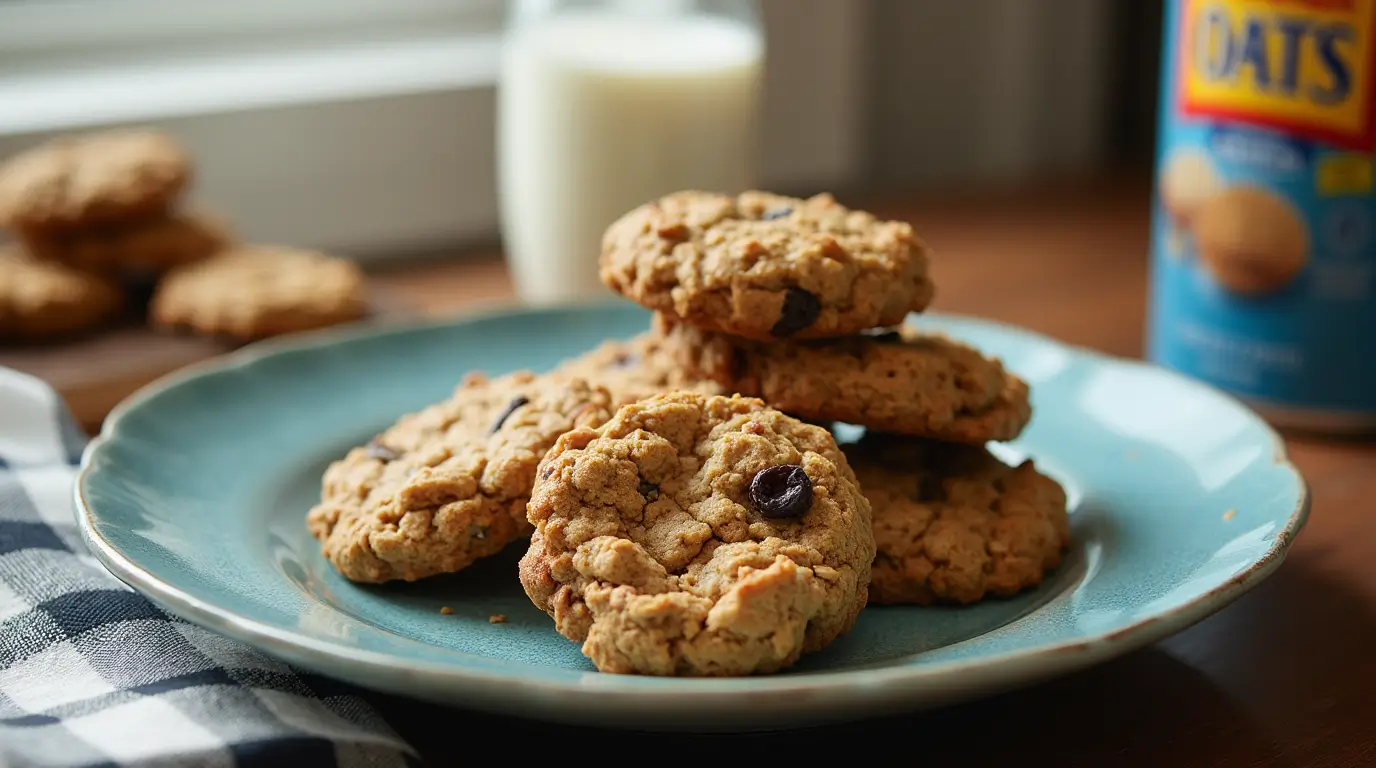original quaker oatmeal cookie recipe
Table of Contents :
Have you ever bitten into a warm, freshly-baked oatmeal cookie and been instantly transported back to childhood? There’s something undeniably comforting about the sweet aroma of cinnamon, brown sugar, and oats wafting through the kitchen. Quaker oatmeal cookies have been a staple in American homes for generations, beloved by both young and old alike. This guide will provide you with the most authentic and foolproof recipe for the original Quaker oatmeal cookie, along with a fascinating look at its history. Whether you’re a seasoned baker or just starting out, this recipe will help you create delicious cookies that taste just like Grandma’s.
A Deep Dive into the History of the Quaker Oatmeal Cookie
Early Days of Quaker Oats
The story of the Quaker oatmeal cookie begins with the Quaker Oats Company itself. Founded in 1877 when Ferdinand Schumacher and Henry Parsons Crowell merged their respective oat milling companies, the Quaker Oats Company became the first registered trademark for a breakfast cereal in America. The iconic Quaker man logo, representing honesty and integrity, quickly became synonymous with quality oats.
In those early days, oats were primarily considered horse feed in America, not human food. The company faced the challenge of convincing Americans that oats were a nutritious and delicious option for breakfast. Little did they know that their product would eventually become a key ingredient in one of America’s most beloved cookies!
The Origins of the Recipe
The earliest documented appearance of an oatmeal cookie recipe on Quaker Oats packaging dates back to the early 1900s. Before this, oatmeal cookies existed in various forms, often appearing in community cookbooks as “oat cakes” or “oatmeal biscuits.” These early versions were typically less sweet and more rustic than the cookies we enjoy today.
The watershed moment came in 1908 when Quaker Oats began printing a recipe for “Oat Cakes” on their packaging. This early recipe was fairly simple, calling for:
- 2 cups Quaker Oats
- 1/2 cup sugar
- 1 tablespoon butter
- 2 eggs
- 2 teaspoons baking powder
- 1/2 teaspoon salt
By the 1930s, the recipe had evolved significantly. The 1929 edition of the Quaker Oats “Creative Cookery” booklet featured a recipe much closer to the one we recognize today, including brown sugar and vanilla for deeper flavor. Interestingly, raisins weren’t included in the standard recipe until the late 1930s, despite modern associations between oatmeal cookies and raisins.
The recipe continued to evolve throughout the 20th century. The biggest change came after World War II, when the amount of butter and sugar increased, reflecting America’s post-war prosperity and changing tastes. By the 1950s, the “Vanishing Oatmeal Cookie” recipe appeared on the Quaker Oats container—a version very similar to what we now consider the classic recipe.
One common misconception is that the recipe on modern Quaker Oats containers is the “original” recipe. In fact, this recipe has been modified numerous times over the decades to accommodate changing tastes and ingredient availability. What we’ll share today is a careful reconstruction of the most beloved version, which emerged in the mid-20th century.
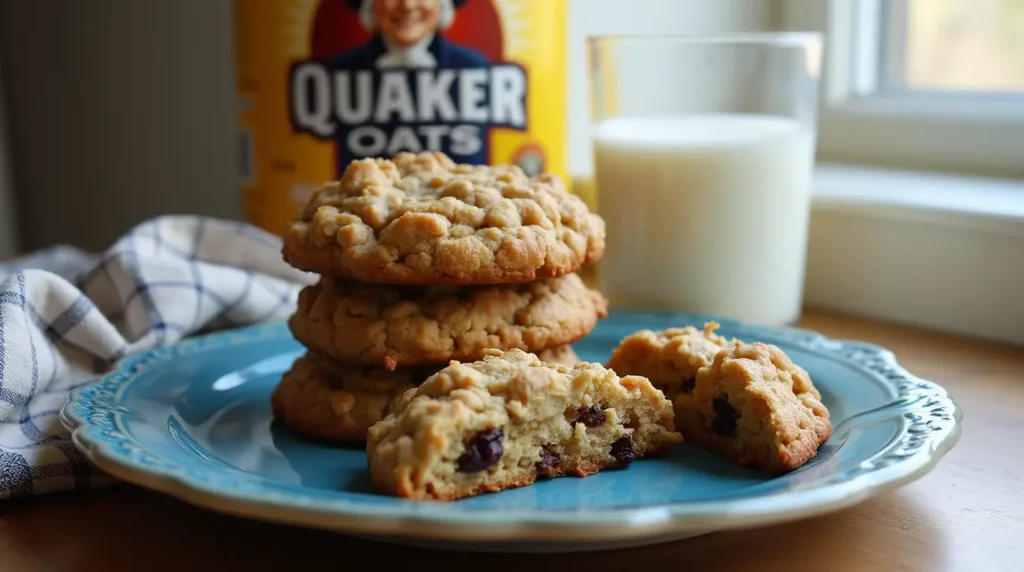
The Role of Quaker Oats in Promoting the Recipe
Quaker Oats was truly pioneering in their marketing approach. They understood early on that providing recipes using their product would boost sales. By printing cookie recipes directly on their packaging, they created a powerful marketing tool that turned their product from a simple breakfast food into a versatile kitchen staple.
In the 1920s and 1930s, the company distributed free recipe booklets featuring dozens of ways to use oats beyond breakfast porridge. These booklets, with titles like “Creative Cookery” and “The Quaker Oats Treasury of Recipes,” became treasured possessions in many American kitchens.
The company also employed smart advertising strategies, often featuring images of happy families enjoying oatmeal cookies together. During the Great Depression, they emphasized the economical aspects of oatmeal cookies—they were filling, nutritious, and relatively inexpensive to make, perfect for stretching tight budgets.
By the mid-20th century, Quaker Oats had firmly established their oatmeal cookie recipe as an American classic. The recipe’s appearance on every container of Quaker Oats ensured its place in culinary history and in the hearts (and stomachs) of generations of Americans.
The Authentic Recipe (Tried, Tested, and Perfected)
After extensive research into historical Quaker recipes and testing multiple variations, I’ve reconstructed what I believe to be the most authentic and beloved version of the Quaker oatmeal cookie. This recipe produces cookies with the perfect balance of chewiness and crispness, with a rich buttery flavor complemented by the nutty oats.
Ingredient List : original quaker oatmeal cookie recipe :
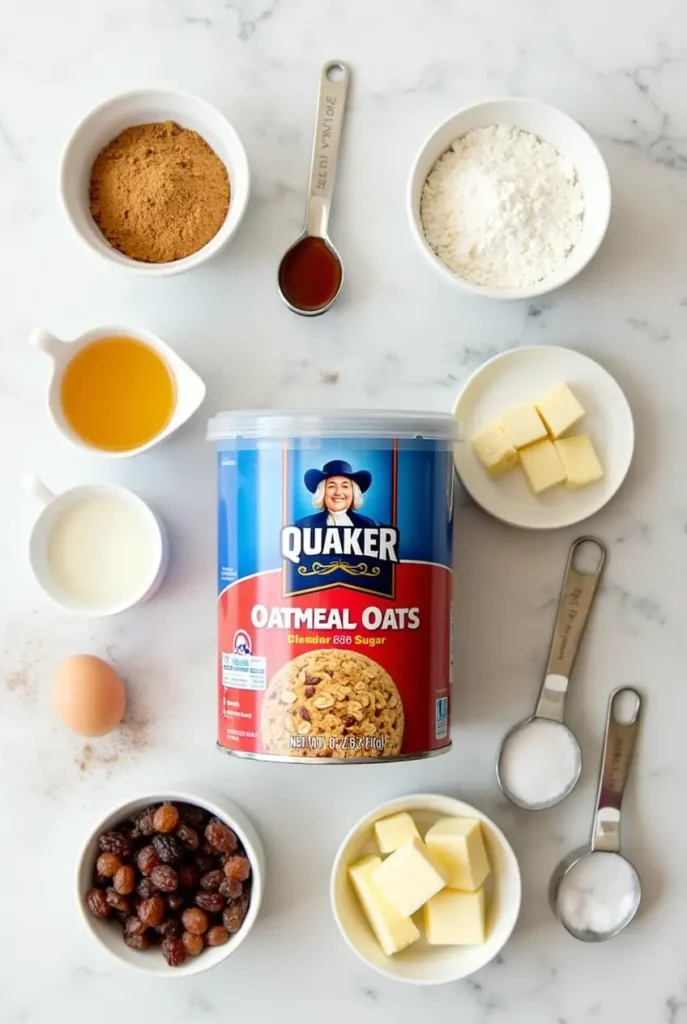
For approximately 4 dozen cookies:
- 1 cup (226g/8oz) unsalted butter, softened
- 1 cup (200g) firmly packed brown sugar
- 1/2 cup (100g) granulated sugar
- 2 large eggs at room temperature
- 1 teaspoon pure vanilla extract
- 1 1/2 cups (190g) all-purpose flour
- 1 teaspoon baking soda
- 1 teaspoon ground cinnamon
- 1/2 teaspoon salt (if using salted butter, reduce to 1/4 teaspoon)
- 3 cups (270g) Quaker Old Fashioned Rolled Oats
- 1 cup (150g) raisins (optional)
Notes on Ingredients:
- Butter: Use real butter, not margarine, for authentic flavor. The butter should be softened but not melted for proper creaming.
- Brown Sugar: Dark brown sugar gives a deeper molasses flavor, while light brown sugar provides a milder taste. Either works well.
- Eggs: Room temperature eggs incorporate better into the dough.
- Vanilla: Pure vanilla extract, rather than imitation, makes a noticeable difference in flavor.
- Oats: Old-fashioned rolled oats are key for authentic texture. Quick oats will work in a pinch but will produce a different texture. Never use instant oats for cookies.
- Raisins: Traditional, but optional. You can substitute with an equal amount of chocolate chips or nuts if preferred.
Step-by-Step Instructions : original quaker oatmeal cookie recipe:
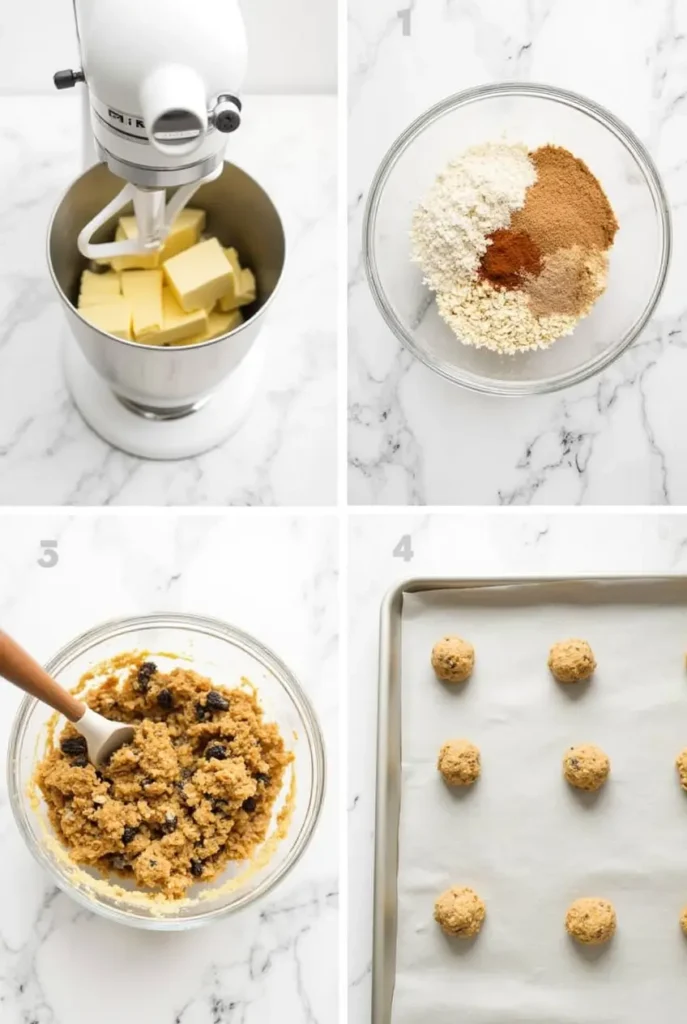
- Preheat your oven to 350°F (175°C). Line baking sheets with parchment paper or silicone baking mats.
- Cream the butter and sugars: In a large bowl, beat the softened butter with both sugars until the mixture is light and fluffy, about 3-4 minutes. Don’t rush this step—proper creaming incorporates air into the dough, which helps the cookies rise.
- Add eggs and vanilla: Beat in the eggs one at a time, mixing well after each addition. Stir in the vanilla extract.
- Combine dry ingredients: In a separate bowl, whisk together the flour, baking soda, cinnamon, and salt.
- Combine wet and dry ingredients: Gradually add the flour mixture to the butter mixture, mixing on low speed just until combined. Do not overmix.
- Add oats and raisins: Stir in the oats and raisins (if using) by hand until evenly distributed.
- Chill the dough: For best results, cover the dough and refrigerate for at least 30 minutes (or up to 2 days). This helps prevent spreading and enhances flavor development.
- Portion the dough: Using a cookie scoop or tablespoon, drop rounded portions of dough onto the prepared baking sheets, spacing them about 2 inches apart.
- Bake: Bake in the preheated oven for 10-12 minutes, or until the edges are lightly golden but the centers still look slightly underdone. For crispier cookies, bake 1-2 minutes longer.
- Cool: Allow the cookies to cool on the baking sheets for 5 minutes, then transfer to wire racks to cool completely.
Baking Tips : original quaker oatmeal cookie recipe
Troubleshooting Common Issues:
- Cookies spreading too much? The butter might be too soft, or the dough too warm. Chill the dough longer before baking, or try increasing the flour by 2-3 tablespoons.
- Cookies not spreading enough? Your oven might be running cool, or the dough might be too cold. Let the dough come to room temperature before baking, or flatten the cookie dough balls slightly with your hand before baking.
- Cookies browning too quickly? Your oven might be running hot. Lower the temperature by 25°F and watch them closely.
For Perfect Texture:
- For chewier cookies, slightly underbake them and remove when the edges are set but the centers are still soft.
- For crispier cookies, bake until the edges are golden brown.
- Allow the cookies to cool completely on a wire rack for the best texture.
Storage Tips:
- Store in an airtight container at room temperature for up to 5 days.
- To maintain freshness, place a slice of bread in the container with the cookies. The bread will go stale instead of your cookies!
- Freeze baked cookies for up to 3 months. Thaw at room temperature for an hour before serving.
- Freeze unbaked cookie dough balls for up to 3 months. Bake directly from frozen, adding 2-3 minutes to the baking time.
Variations on a Theme (Delicious Twists on the Original)
While the classic Quaker oatmeal cookie is perfect as is, sometimes it’s fun to experiment with different flavors and add-ins. Here are some delicious variations to try:
Oatmeal Raisin Cookies
The classic variation is already covered in our main recipe. If you really love raisins, consider these enhancements:
- Soak the raisins in warm water (or rum for adults!) for 10 minutes before adding to the dough. Drain and pat dry. This plumps them up and makes them juicier.
- Try a mix of golden and regular raisins for visual appeal and subtle flavor differences.
Oatmeal Chocolate Chip Cookies
Simply substitute the raisins with an equal amount of chocolate chips. For an extra special treat:
- Use a combination of milk, semi-sweet, and dark chocolate chips for depth of flavor.
- Add 1/4 teaspoon of espresso powder to enhance the chocolate flavor.
- For a more decadent cookie, drizzle melted chocolate over the cooled cookies.
Oatmeal Nut Cookies
Add 1 cup of chopped nuts to the basic recipe. Walnuts and pecans work particularly well, but almonds and hazelnuts are delicious too.
- Toast the nuts before adding them to the dough for enhanced flavor.
- For the ultimate nut cookie, add 1 tablespoon of nut butter (such as almond or peanut butter) to the dough.
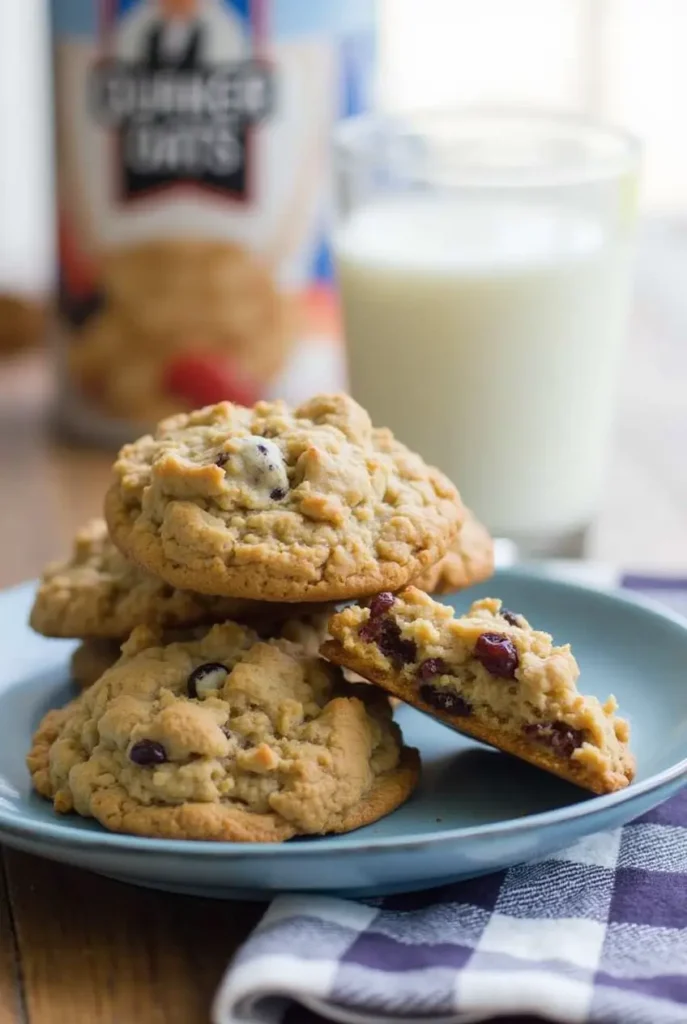
Creative Variations
Cranberry White Chocolate Oatmeal Cookies
- Substitute raisins with 3/4 cup dried cranberries and add 3/4 cup white chocolate chips.
- Add the zest of one orange for a bright flavor accent.
Spiced Oatmeal Cookies
- Double the cinnamon and add 1/4 teaspoon each of nutmeg, allspice, and ginger.
- Add a pinch of black pepper for a subtle heat that enhances the other spices.
- Perfect for fall and winter holidays!
Oatmeal Coconut Cookies
- Add 1/2 cup of shredded coconut to the dough.
- For extra coconut flavor, substitute half the vanilla extract with coconut extract.
“Kitchen Sink” Oatmeal Cookies
- Add 1/3 cup each of chocolate chips, raisins, chopped nuts, and shredded coconut.
- These hearty cookies make great fuel for hiking or busy days.
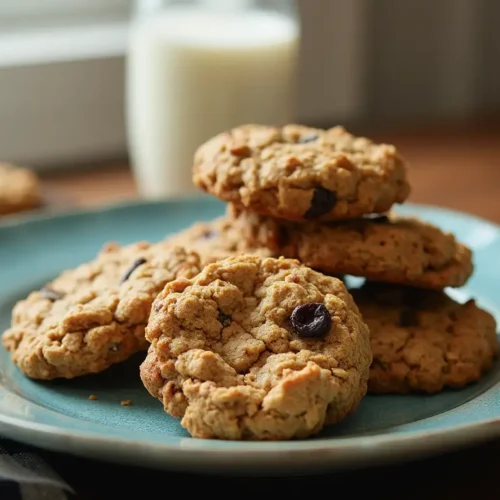
original quaker oatmeal cookie recipe
Ingredients
- 1 cup 226g/8oz unsalted butter, softened
- 1 cup 200g firmly packed brown sugar
- 1/2 cup 100g granulated sugar
- 2 large eggs at room temperature
- 1 teaspoon pure vanilla extract
- 1 1/2 cups 190g all-purpose flour
- 1 teaspoon baking soda
- 1 teaspoon ground cinnamon
- 1/2 teaspoon salt
- 3 cups 270g Quaker Old Fashioned Rolled Oats
- 1 cup 150g raisins (optional)
Instructions
- Preheat your oven to 350°F (175°C). Line baking sheets with parchment paper or silicone baking mats.
- In a large bowl, beat the softened butter with both sugars until the mixture is light and fluffy, about 3-4 minutes.
- Beat in the eggs one at a time, mixing well after each addition. Stir in the vanilla extract.
- In a separate bowl, whisk together the flour, baking soda, cinnamon, and salt.
- Gradually add the flour mixture to the butter mixture, mixing on low speed just until combined. Do not overmix.
- Stir in the oats and raisins (if using) by hand until evenly distributed.
- Cover the dough and refrigerate for at least 30 minutes (or up to 2 days).
- Using a cookie scoop or tablespoon, drop rounded portions of dough onto the prepared baking sheets, spacing them about 2 inches apart.
- Bake in the preheated oven for 10-12 minutes, or until the edges are lightly golden but the centers still look slightly underdone.
- Allow the cookies to cool on the baking sheets for 5 minutes, then transfer to wire racks to cool completely.
- RetryClaude can make mistakes. Please double-check responses.
Frequently Asked Questions (FAQs) : original quaker oatmeal cookie recipe
Can I use quick oats instead of rolled oats?
Yes, you can use quick oats, but the texture of your cookies will be different. Quick oats produce a softer, less chewy cookie with less obvious oat texture. For the authentic Quaker oatmeal cookie experience, old-fashioned rolled oats are recommended. Never use instant oatmeal packets, as they contain additives and sweeteners that will throw off the recipe.
Why are my cookies flat?
Several factors can cause flat cookies:
Butter that’s too soft or melted
Not enough flour
Overmixing the dough (which develops too much gluten)
Baking soda that’s no longer active
Oven temperature that’s too low
To fix flat cookies, try chilling your dough thoroughly before baking and make sure your oven is properly preheated.
How long do oatmeal cookies last?
When stored in an airtight container at room temperature, oatmeal cookies will stay fresh for 4-5 days. For longer storage, freeze them in an airtight container with parchment paper between layers for up to 3 months.
Can I freeze the dough?
Absolutely! Oatmeal cookie dough freezes beautifully. You can freeze it in two ways:
As a whole batch: Wrap the dough tightly in plastic wrap, then in foil. Freeze for up to 3 months. Thaw in the refrigerator overnight before using.
As pre-portioned cookies: Scoop the dough onto a baking sheet, freeze until solid, then transfer the frozen dough balls to a freezer bag. Bake directly from frozen, adding 2-3 minutes to the baking time.
Can I reduce the sugar in this recipe?
You can reduce the sugar by up to 25% without significantly affecting the texture. However, sugar does more than just sweeten cookies—it provides moisture and affects spread. If you reduce the sugar too much, your cookies may be drier and less chewy. Consider using natural sweeteners like mashed banana or applesauce to replace some of the sugar if you’re looking to make healthier cookies.
Why did my oatmeal cookies turn out hard?
Hard cookies are usually the result of overbaking or using too much flour. Remember that cookies continue to firm up as they cool, so it’s better to slightly underbake them if you prefer a softer texture. Also, measure your flour correctly by spooning it into the measuring cup and leveling it off, rather than scooping directly from the bag, which can compact the flour.
Can I make these cookies gluten-free?
Yes! You can substitute the all-purpose flour with a 1:1 gluten-free baking blend. Make sure to use certified gluten-free oats as well, since regular oats may be processed in facilities that handle wheat products.
What can I use if I don’t have brown sugar?
If you don’t have brown sugar, you can make your own by combining 1 cup of granulated sugar with 1-2 tablespoons of molasses. In a pinch, you can use all white sugar, but your cookies will be crisper and lack the characteristic caramel notes that brown sugar provides.
Conclusion : original quaker oatmeal cookie recipe
There’s something magical about the humble oatmeal cookie. Whether you prefer them soft and chewy or crisp and crunchy, whether you’re Team Raisin or Team Chocolate Chip, these cookies have a way of bringing comfort and joy with every bite. The authentic Quaker oatmeal cookie recipe has stood the test of time for good reason—it’s simple, adaptable, and absolutely delicious.
By understanding the history behind these beloved cookies and mastering the techniques that make them special, you’re not just baking a sweet treat; you’re participating in a tradition that spans generations. So preheat that oven, gather your ingredients, and prepare to fill your kitchen with the irresistible aroma of freshly baked oatmeal cookies.
I’d love to hear about your oatmeal cookie experiences! Do you have a special variation that your family loves? Did you try one of the recipes from this post? Leave a comment below and share your oatmeal cookie stories and photos.

